- Izu Peninsula top
- General
- Earthquake and volcano
- Too many deer in Izu
- East
- Ito - its old buildings
- Anjin = Wlliam Adams and Ito
- Religious Charisma Nichiren
- Washtub race
- Yokikan - Spa ryokan
- Minami-Kaikisen: Auberge
- Ike and its paddy fields
- Summer has come!!!
- Inatori - fish, spa and more
- Central
- Banjo Waterfall
- Mount Amagi
- Shuzenji - old spa town
- Arabashiri - Bandai-Jozo
- Oomi Land - heart of Izu
- West and south
- Heda on the west coast
- Toi - Gold mine
- Matsuzaki - namako wall
- Izu-no-Chohachi - Plasterer
- Kumomi on the west coast
- Shimoda - Tojin-Okichi
- Cottage life
- Fishing in Usami
- Start of my fishing life
- Training camp in Amagi
- Cottage life / music&drinks
- Party in Izu - part 2
- Party in Izu - part 1
- Sunday morning concert
- Ice and snow in Amagi
- My summer house
- Restaurant and eatery
- Let’s eat Izu-Deer!
- Isui-an - exquisite soba
- Sugizen - big prawn fry
- Sayang - Bali restaurant
- Restaurant Tanaka

An idyllic view of Jizodo with cosmos flowers and taro leaves in the foreground
Oomi land - heart of Izu
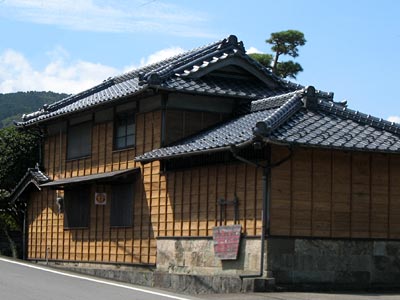
A newly restored house; the color of wooden boards is still fresh.
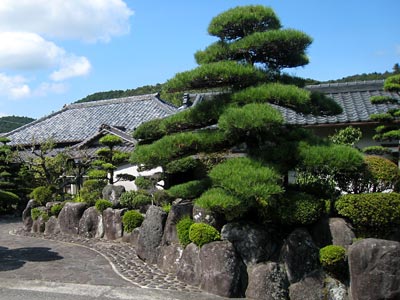
The entrance of an house with trimmed trees and a stone wall
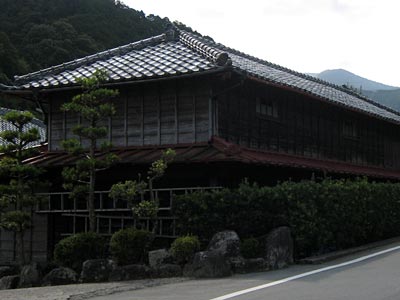
An old shed shows the color of aged wooden buildings
I believe this is the reason why I feel particularly comfortable and relaxing in this part of Izu. Especially in its mountainous areas such as Jizodo, Warabo, Kisobo, Ikadaba, Wasabida, Himenoyu and Sugehiki, there is neither super market, nor convenience store, nor pachinko parlor, and I feel as if I were back to the 1950s, when the Japanese economic miracle had not taken place yet. In short, we can find there very little trace of ugly consumerism, but a modest and ordinary life of agricultural provinces.
In Jizodo, the uppermost village in Oomi Land, the valley is narrow and a number of old wooden houses with ceramic-tiled roofs are preserved. It is nice to see newly restored houses with traditional wooden boards wall. After a while new houses will be melted into the neighborhood.
I would like to highly evaluate the willingness of the villagers to try to maintain the traditional landscape. I am fond of efforts of every family to try to maintain nice shaped garden trees, beautiful flowers of the season and old stone walls.
Among their efforts I found their garbage storages both innovative and cool. There are in total fourteen fancy storages in Oomi Land where neighbors store their daily garbage till it is collected by the municipality's garbage truck.
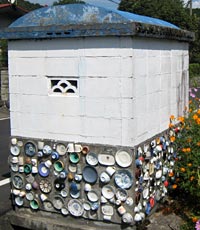 This example in Jizodo in decorated in its lower part with some 200 porcelains. Villagers were asked by the municipality government to plan and build 14 garbage storages in 1988 so that they would not any more throw garbage away as something dirty and stinking. This idea proved extremely successful. Garbage storages have become pride objects of the villagers and they want others to see their art works. The surroundings of garbage storages are kept clean by volunteers and signboards are hung on the wall for community information. Such storages might look strange in urban areas, but they have become a part of the landscape of Oomi Land.
This example in Jizodo in decorated in its lower part with some 200 porcelains. Villagers were asked by the municipality government to plan and build 14 garbage storages in 1988 so that they would not any more throw garbage away as something dirty and stinking. This idea proved extremely successful. Garbage storages have become pride objects of the villagers and they want others to see their art works. The surroundings of garbage storages are kept clean by volunteers and signboards are hung on the wall for community information. Such storages might look strange in urban areas, but they have become a part of the landscape of Oomi Land.Though Jizodo has little to do with loud tourism, it looks wealthy. That might be thanks to the wasabi farming. While most of the wasabi farmers simply grow wasabi and sell roots to the agricultural cooperative, there are a few who are engaged with processing of wasabi roots and leaves and with agritourism such as Oomiya, which I introduced in another article.
The fact that the area is suitable for wasabi growing indicates the abundance of pure fresh water with a stable temperature throughout the year. Rivers and numerous irrigation canals flowing through the fields are filled with fresh water. Many people say that the water in Oomi Land tastes excellent and it is ideal as drinking water.
Because Oomi Land is such a comfortable place to live, already in the Neolithic period, some 3,000 or 4,000 years ago, people lived here and left a stone circle. Each village maintains its own traditional festivals in particular to express thanks to gods for good harvest.
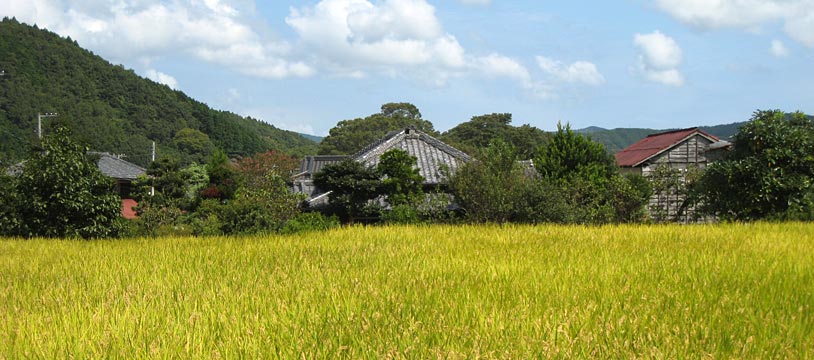
Rice is about to be harvested.
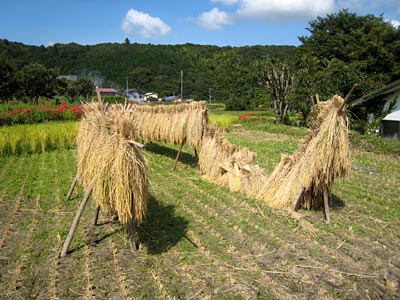
The reaped rice is being dried on the field; on this photo a part of the support seems to be broken.
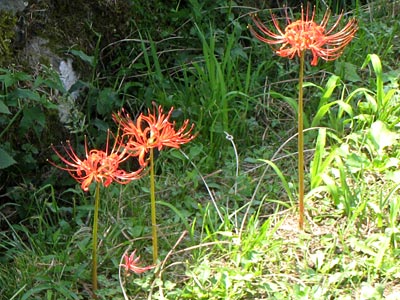
Higanbana
The place names I listed above might not mean much for foreigners. But, as a Japanese man I find those names very unusual. We can hardly find the same names in other places of Japan and some of them have special ways of reading Chinese characters.
Kisobo and Jizodo obviously relate to Buddhism; Kisobo means "noble monk's hatch" and must be named after an esteemed monk Gohou-Zenji who stayed here in 1430s. Jizodo means a small temple for Jizo-bosatsu (Ksitigarbha), but its origin is unclear.
There are also names which describe the landscapes of Nakaizu. "Wasabida" means "wasabi field". "Ikadaba" means "anchorage of timber rafts". "Himenoyu" on the other hand means "princess spa" and sounds romantic. It is understandable that "Ai Ai Himenoyu", an emergency shelter for the people who are hypersensitive against chemical substances, is built here in Himenoyu.
One typically difficult case of reading Chinese characters is "Hatsuma". Its two Chinese characters are usually read either "Hachiman" or "Yawata" and it is the name of a war god especially worshiped by the Genji Clan. Hatsuma might be a corruption of Hachiman, but I am sure that the Japanese people from other regions can never read the name.
I put here some photos of the scenes I like. Now, rice is about to be harvested.
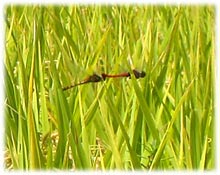
The reaped rice is first dried on the spot. Dragonflies are pairing and cosmos and spider lilies are blooming.
The poisonous spider lily is called Higanbana, Manjushage or Manjushaka in Japanese. Higanbana is a strange plant; when flowers bloom no leaves exist and after the flower season grow leaves. Spider lily contains poison, in particular in its bulb. Maybe because of this toxicity, Higanbana is thought to be a ominous flower in Japan and has many weird names such as dead’s flower, hell flower, ghost flower, orphan flower, toothless hag and so on. However, Yamaguchi Momoe sang the red color of Manjushaka as symbolizing the soul of a loving woman.
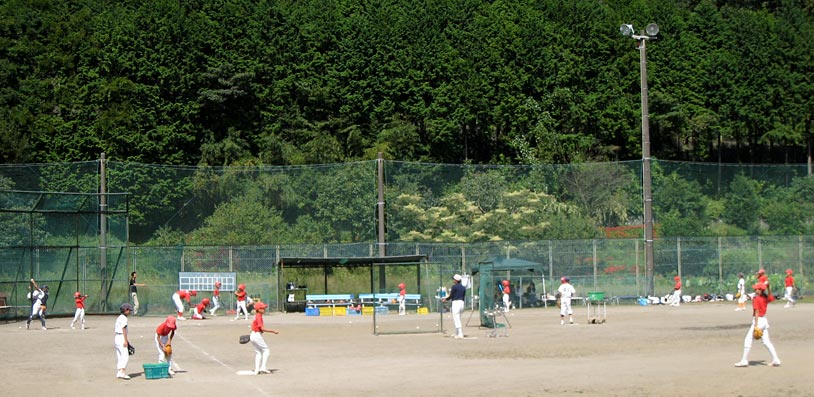
Village children are training for baseball.